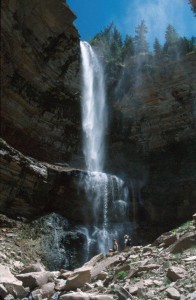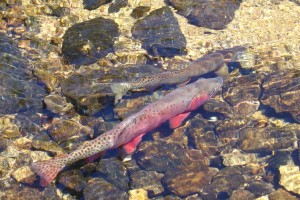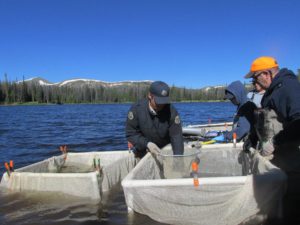2016 was a big year for Colorado TU, the last 11 months have seen challenges present themselves from protecting our headwaters from acid mine drainage, to making sure our public lands remain in public hands, to ensuring the state's quality of water and natural habitat. While these challenges threatened our rivers and streams, the work by TU and it's chapters, made sure these threats remained just that and our watersheds remained protected. CTU also embarked on programs that would help sustain conservation and fishing for years to come. We engaged the next generation of river stewards through our Youth Camp, introduced a new group of kids to conversation through fly fishing, reintroduced native greenback cutthroat trout to their home watersheds along the front range, and made on-the-ground improvements to our state's fisheries through our chapter's volunteer efforts.
There were many great success stories over the last year that will be covered in the 2016 Year in Review coming out early 2017. The few stories listed below are highlights of the last year for CTU and just a glimpse into the great work done by the TU staff, our chapters, volunteers, and partners! Stay tuned for the 2016 Year in Review for more articles covering all of the great work done in Colorado!
Roan Plateau

Throughout the past decade, Colorado TU has also been involved in advocacy and litigation to help protect the Roan in the face of proposed oil and gas development. The legal battle culminated in productive settlement talks that produced the new Roan plan that BLM approved in November. For the next 20 years, the most sensitive watersheds atop the Roan will remain unleased, while responsible development will be allowed on other areas on and around the Plateau that are closer to existing oil and gas infrastructure. Continued improvements in directional drilling technology over those years could make it possible, by the time BLM next updates the Roan plan, to extend development to natural gas reserves below the Roan without needing to sacrifice the valuable habitat on its surface. This agreement is a great example of how balance can be achieved when all parties sit down and try to listen honestly and respectfully to each other to craft a solution.
Thompson Divide

Concurrent with the Roan decision, The BLM also issued a decision canceling 25 contentious oil and gas leases within the Thompson Divide (the leaseholders to be repaid from government funds), while maintaining 40 other leases in surrounding lands – mostly closer to existing development areas. As with the Roan, the decision reflects a responsible balance between protecting our most valuable fish and wildlife habitats and enabling responsible energy development to move forward on public lands. Unlike the Roan, this decision does not yet reflect a larger consensus among conservationists and industry, nor does it provide longer-term protection for the Thompson Divide. The decision was a necessary victory in protecting the Thompson Divide from the imminent threat of oil and gas drilling, and TU remains committed to working with the BLM, Forest Service, ranchers, local governments, and the oil and gas industry to achieve a long-term solution that includes permanent protection of the Thompson Divide as part of a larger, responsible plan for energy development in the region.
Stream Standards

Trout Unlimited and a coalition of agencies, concerned citizens, and conservation and sportsmen groups rallied to defend Colorado’s water quality standards for temperature in coldwater streams. The Colorado Water Quality Control Division (WQCD) proposed changes in standards that would have raised standards for water temperature to levels that could prove fatal to trout in spring and fall seasons and year-round in mid-elevation “transition” waters. The proposal was based on flawed science and failed to adequately protect coldwater fisheries and to address the varied factors that influence temperature regimes in natural streams. Thanks to the efforts of TU and our coalition partners, the Water Quality Control Commission (WQCC) rejected the proposed changes, keeping in place the protective temperature standards that currently apply to coldwater streams. It was an impressive team – including Colorado Parks and Wildlife, the Colorado Wildlife Federation, the Environmental Protection Agency (EPA), Western Resource Advocates, and others. The proposed changes would have weakened water temperature standards for around 1/3 of Colorado’s trout streams, based solely on their elevation, allowing the fish’ stress levels to increase and ultimately cause problems for feeding, growth and movement. According to the EPA, the proposed standards for lower elevation coldwater streams could have actually proved lethal to trout exposed to them over seven days.
Greenback Recovery
 Colorado TU teamed up with Colorado Parks and Wildlife to reintroduce Greenback Cutthroat trout into their native watersheds all along the Front Range. Efforts this past year including spawning Zimmerman Lake, receiving grants to help improve the Mt. Shavano fish hatchery that raises Greenbacks, and expanded Greenback efforts to educating the public on why all native trout reintroduction is vital to our ecosystems. CTU has also worked with Parks and Wildlife on preliminary plans for a fish barrier on Rock Creek that will eventually hold Greenbacks. CTU volunteers worked with CPW on the beginning stages of the project by stocking fish in a section of the stream.
Colorado TU teamed up with Colorado Parks and Wildlife to reintroduce Greenback Cutthroat trout into their native watersheds all along the Front Range. Efforts this past year including spawning Zimmerman Lake, receiving grants to help improve the Mt. Shavano fish hatchery that raises Greenbacks, and expanded Greenback efforts to educating the public on why all native trout reintroduction is vital to our ecosystems. CTU has also worked with Parks and Wildlife on preliminary plans for a fish barrier on Rock Creek that will eventually hold Greenbacks. CTU volunteers worked with CPW on the beginning stages of the project by stocking fish in a section of the stream.


